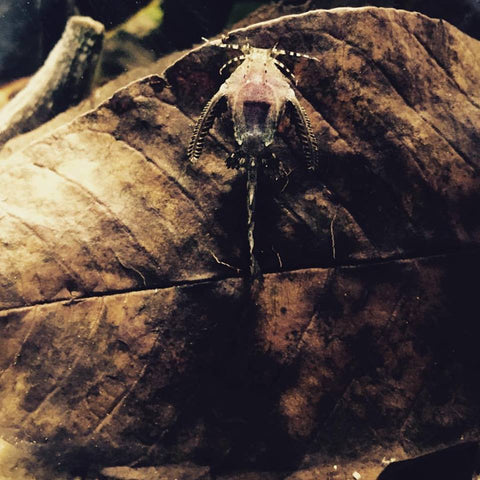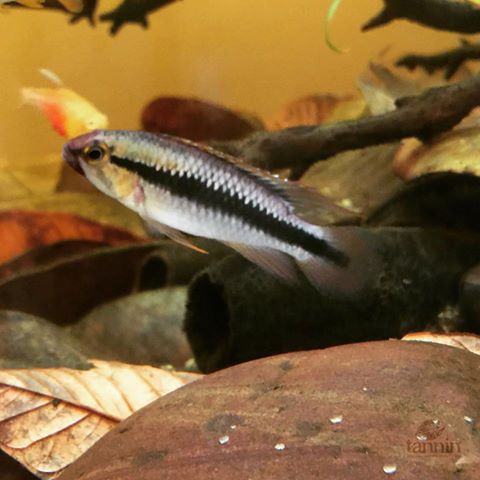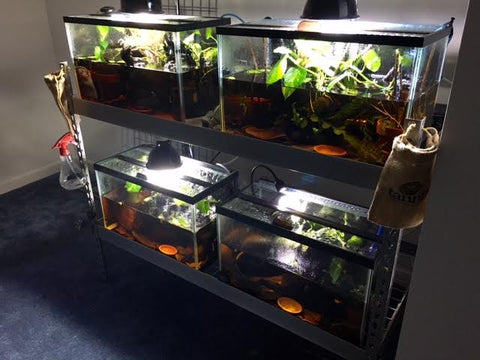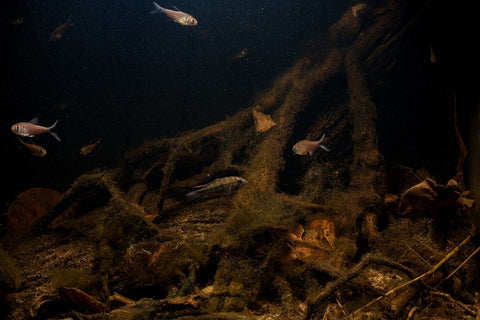- Continue Shopping
- Your Cart is Empty
To breed or not to breed...?
Okay, this is kind of a fair question, actually...
With so many hobbyists getting into the idea of botanical-influenced blackwater aquariums, I know a fair number of us are trying to create natural conditions to stimulate breeding of fishes.

Others are experimenting with the purported "therapeutic" aspects of blackwater and the botanicals which help create it (i.e.; Catappa, etc.) Yet, many of us are simply trying to create a cool-looking tank, to savor a new aesthetic experience. Any spawning events with fishes that take place in our aquariums are seen as a delightful, yet random, occurrence.
In our office aquarium, which you've seen splashed over these pages and on our social media feeds, we've chosen to use this this tank as more of a "poster child" for the "Botanical" approach. The idea was to create a fairly natural-looking aesthetic, and select fishes that came from this environment, such as characins and dwarf cichlids.This has worked out very well, with the fishes displaying incredible coloration, relaxed behavior, excellent appetite...and, on several occasions- spawning behaviors!
A few weeks ago, I had contacted my friend, William Garden of The Cichlid Garden, one of the top Apisto breeders in the U.S.- about obtaining a few new fishes to add to the tank. I felt that it would be a lot of fun to have a group of Apistos in this aquarium, to add some color, interest, and perhaps-some incidental spawning...although the spawning was not really on my mind in this display. I have really fallen for the behaviors, color, and personalities of these cool little cichlids.
I started looking to create a little colony of Apisotgramma bitaeniata, which I was smitten with at the time.
And William, ever the hobbyist, asked me this awesome question: "Do you want to breed them, or just have a cool-looking group?" And I was thinking, "Wow- great question..." I really didn't have the time to create spawning tanks and rearing systems, and to me, it was really more about the behaviors and seeing the fishes interact in an interesting environment. And of course, he had an idea, "Why don't I send you some various selected males of different species that you can keep in that tank? They'd make a cool display!"
And guess what? He was right! I now have a little cadre of Apistos: A. cacatuoides "Triple Red", A. bitaeniata, A. abacaxis, and A. atohualpa. And guess what? They all get along like a bunch of beer-swilling college buddies!
Oh, the occasional little "tiff" might break out between the larger ones (the really large cacatuoides and the atohualpa), but that's it. Just a little "nudge" here and there. No protracted territorial battles. No vengeance killings. No one cowering in the corners. They sorted it out from day one, and now they are always hanging out and interacting together, forming a little "clique" and displaying and darting around the lower reaches of the tank.

They spend their days diving in and out of the leaf litter, flashing for each other- and just adding to the overall color and interest of an already fairly unique aquarium. Just generally looking cool.
The idea of keeping fishes for the sake of enjoying their appearance is as old as the idea of keeping fishes in aquariums. The allure of breeding is as important and strong as ever, but I've noticed that simply keeping beautiful fishes in environments that are conducive to their health, coloration, behavior- and spawning- creates a truly memorable and enjoyable display and hobby in and of itself. Seems like, whenever I visit a fish room of a well-known breeder, they always have at least a few display only tanks to simply enjoy their fishes.

And many hobbyists, for a variety of reasons- simply want to enjoy looking at their fishes in a cool tank. They don't have the time, inclination, economic ability, space, or interest, to go int a full scale breeding program. And that's perfectly okay. Who says we have to breed every fish we keep?
So, in my opinion, the goal of keeping tropical fishes, wether you're intending to just savor them in a pretty tank, rear them, or breed them- is to provide optimal conditions for their health, appearance, coloration, and longevity. And if they just "happen" to reproduce- well, what bonus, right? The "icing on the cake!" Treat your fishes like you're trying to spawn them- in terms of environment, food, etc., and at the very least, you end up with some amazingly nice looking fishes to enjoy! Win-win for your fishes- and for the hobby.
The answer to the question, "To breed or not to breed?" is moot. Irrelevant. Rather, it makes more sense to simply "do what we do" as fish geeks: Enjoy them. Just as many secrets can be unlocked by keeping fishes in optimal, nature-like conditions as can be gleaned by spawning and rearing them, IMHO.
The first step to getting delicate, rare, or otherwise seldom-kept fishes to spawn is to simply keep them alive long enough to reach a reproductive condition...and then to help them thrive. The work done to get to the "spawning phase" is every bit as important- although seemingly not a "sexy"- as the work that goes into spawning them and rearing that first batch of fry from said fish!

We all can make important contributions to the body of knowledge that makes up the art and science of tropical fish keeping. Whether it's perfecting their captive environment, studying their behaviors, needs, and interactions, working out their dietary requirements- or rearing their fry- every step along the way as a valuable contribution. Sharing your endeavors is so important- they unlock so many doors.
Don't ever lose sight of that.
Say engaged. Stay excited.
And Stay Wet.
Scott Fellman
Tannin Aquatics
















Scott Fellman
Author